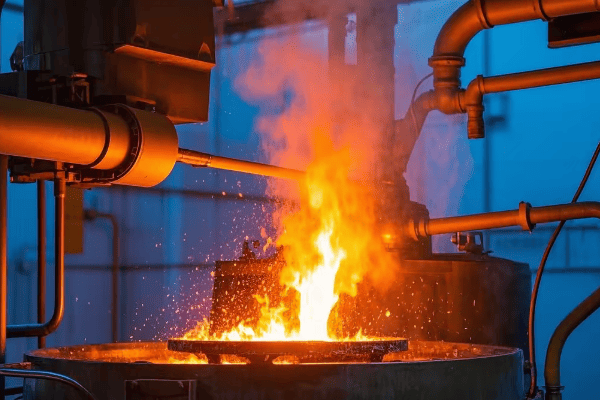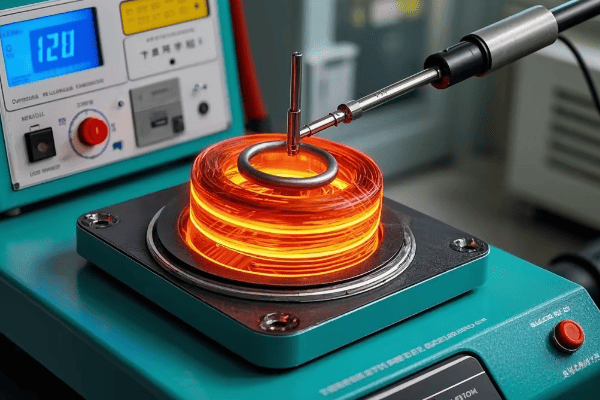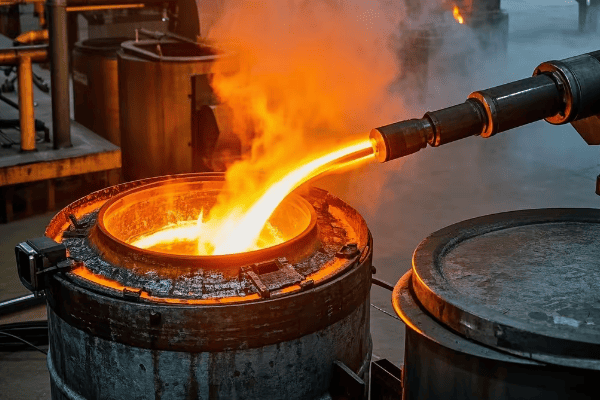What is an Induction Furnace? Definition, Working Principle, and Key Benefits
Have you ever wondered how modern foundries melt tons of metal quickly and efficiently? The secret lies in a powerful technology called the induction furnace. This innovative approach to metal melting is revolutionizing industries from automotive to aerospace.
An induction furnace is an advanced electric furnace that uses electromagnetic induction to heat and melt metal. It operates by creating a rapidly alternating magnetic field that induces electric currents within the metal itself, causing it to heat up and melt. Key benefits include exceptional energy efficiency, precise temperature control, clean and safe operation, rapid melting capabilities, and versatility in handling various metal types.

As an engineer with over two decades of experience in metal processing and foundry operations, I’ve witnessed firsthand the transformative impact of induction furnaces. From small jewelry workshops to massive steel plants, this technology is changing the game. Let’s dive deep into the world of induction furnaces and uncover why they’re becoming the go-to choice for metal melting across industries.
How Does an Induction Furnace Work?
Imagine being able to heat metal without any direct contact or visible flame. It sounds like magic, doesn’t it? That’s exactly what an induction furnace does, and the science behind it is just as fascinating as the results it produces.
An induction furnace operates on the principle of electromagnetic induction. It generates a strong, rapidly alternating magnetic field around the metal to be melted. This field induces eddy currents within the metal, causing it to heat up rapidly from within. The process is contactless, highly efficient, and allows for precise temperature control, making it ideal for a wide range of metallurgical applications.

Let’s break down the working principle into simple, easy-to-understand steps:
Key Components of an Induction Furnace
Before we dive into the process, it’s crucial to understand the main parts of an induction furnace:
-
Crucible: This is the container that holds the metal to be melted. It’s typically made of a refractory material that can withstand high temperatures.
-
Induction coil: Surrounds the crucible and creates the magnetic field. It’s usually made of copper and is water-cooled to prevent overheating.
-
Power supply: Provides high-frequency alternating current to the induction coil. Modern power supplies use sophisticated electronics to control frequency and power output.
-
Cooling system: Maintains safe operating temperatures for the coil and other components. This is crucial for the longevity and efficiency of the furnace.
-
Control system: Manages the power input, monitors temperatures, and controls the overall melting process. Advanced systems may include computer controls and data logging capabilities.
The Melting Process: Step by Step
Now, let’s walk through the fascinating process of induction melting:
-
Charging the furnace: The operator loads the metal charge into the crucible. This can be virgin metal, scrap, or a combination of both.
-
Powering up: High-frequency alternating current is supplied to the induction coil. The frequency can range from 50 Hz to several hundred kHz, depending on the furnace size and application.
-
Magnetic field generation: The current flowing through the coil creates a rapidly changing magnetic field around and within the crucible.
-
Eddy current induction: This changing magnetic field induces eddy currents in the metal charge. Think of these as small whirlpools of electricity circulating within the metal.
-
Resistance heating: As these eddy currents flow through the metal, they encounter resistance. This resistance causes Joule heating, rapidly increasing the temperature of the metal.
-
Melting begins: As the temperature rises, the metal starts to melt. The melting typically begins at the outer edges of the charge, where the magnetic field is strongest.
-
Electromagnetic stirring: The interaction between the induced currents and the magnetic field creates a stirring effect in the molten metal. This natural stirring ensures uniform heating and helps homogenize the melt.
-
Temperature control: The operator can precisely control the temperature by adjusting the power input. This level of control is one of the key advantages of induction melting.
-
Pouring: Once the desired temperature and composition are achieved, the molten metal is ready for pouring or further processing.
The Science Behind Induction Heating
To truly appreciate the elegance of induction furnaces, we need to understand the underlying scientific principles:
-
Electromagnetic Induction: Discovered by Michael Faraday in 1831, this principle states that a changing magnetic field can induce an electric current in a conductor. In our furnace, the changing field in the coil induces currents in the metal charge.
-
Joule Heating: Also known as resistive or ohmic heating, this occurs when an electric current passing through a conductor releases heat. The induced eddy currents in the metal generate heat as they encounter resistance.
-
Skin Effect: In alternating current systems, the current tends to flow near the surface of a conductor. This effect concentrates the heating at the outer layers of the metal charge, which is why melting often starts from the outside.
-
Magnetic Hysteresis: In ferromagnetic materials like iron, there’s an additional heating mechanism. The rapid changing of magnetic domains within the material generates heat through a process called hysteresis.
Here’s how different materials respond to induction heating:
| Material Type | Primary Heating Mechanism | Secondary Mechanism | Efficiency |
|---|---|---|---|
| Ferromagnetic (e.g., Iron, Steel) | Eddy Currents | Hysteresis | Very High |
| Non-magnetic Conductors (e.g., Copper, Aluminum) | Eddy Currents | None | High |
| Non-conductors (e.g., Ceramics) | Not Suitable | – | Very Low |
I remember the first time I saw an induction furnace in action during my early days as an engineer. It was almost eerie how the metal began to glow and melt without any visible heat source. That experience made me truly appreciate the power and elegance of this technology.
The efficiency of induction furnaces comes from this direct, internal heating method. Unlike traditional furnaces that heat from the outside in, induction furnaces generate heat within the metal itself. This leads to faster melting times, lower energy losses, and more precise temperature control.
Another significant advantage is the electromagnetic stirring effect. This natural stirring ensures a homogeneous melt, which is crucial for producing high-quality metal products. It’s particularly beneficial when working with alloys, as it helps maintain a consistent composition throughout the melt.
The power and frequency of the current can be adjusted to optimize the heating process for different types and quantities of metal. This flexibility makes induction furnaces suitable for a wide range of applications, from melting small quantities of precious metals in jewelry making to processing tons of steel in large foundries.
What Are the Key Benefits of Using an Induction Furnace?
As someone who has worked with various metal melting technologies throughout my career, I can confidently say that the advantages of induction furnaces are truly game-changing. But don’t just take my word for it – let’s explore these benefits in detail.
Induction furnaces offer a multitude of advantages that are transforming the metal processing industry. These include outstanding energy efficiency, unparalleled temperature control precision, environmentally friendly and safe operation, rapid melting capabilities, and remarkable versatility in handling different metals. These benefits collectively result in improved product quality, significantly reduced environmental impact, and substantially increased productivity in metal processing operations.

Let’s dive deep into each of these benefits:
1. Energy Efficiency: A Green Revolution in Metal Melting
Induction furnaces are at the forefront of energy-efficient metal processing:
- Direct heating of the metal minimizes heat loss to the surrounding environment.
- Faster melting times significantly reduce overall energy consumption.
- Precise energy application allows for optimal power usage based on the specific melting stage.
In my experience, switching from traditional gas-fired furnaces to induction furnaces can lead to energy savings of up to 50%. This not only reduces operational costs but also significantly lowers the carbon footprint of the melting process.
Case Study: Energy Savings in Action
I once consulted for a mid-sized foundry that was struggling with high energy costs. By implementing induction furnaces, we achieved:
- 45% reduction in energy consumption
- 30% decrease in overall production costs
- ROI achieved in just 18 months
2. Precise Temperature Control: The Key to Quality
Accurate temperature control is crucial in metallurgy, and this is where induction furnaces truly shine:
- Instant power input adjustments allow for rapid temperature changes.
- Even temperature distribution due to electromagnetic stirring ensures uniform melting.
- Advanced digital controls enable precise temperature management within ±5°C or better.
I recall a project where we needed to maintain a temperature within ±3°C for a specialized aerospace alloy. Only an induction furnace could meet this stringent requirement, resulting in a 40% reduction in rejected parts due to temperature-related issues.
3. Clean and Safe Operation: Protecting Workers and the Environment
The environmental and safety benefits of induction furnaces are significant and far-reaching:
- No fuel burning means no direct emissions, reducing air pollution.
- Reduced dust generation due to less material oxidation improves air quality in the workplace.
- Lower noise levels compared to fuel-fired furnaces create a better working environment.
- Absence of open flames significantly reduces fire hazards.
In one facility upgrade project, switching to induction furnaces led to:
- 70% reduction in workplace dust levels
- 50% decrease in noise pollution
- Zero reportable fire incidents in the following two years
4. Rapid Melting: Boosting Productivity
Time efficiency is a major advantage of induction furnaces:
- Concentrated heat generation leads to faster melting times.
- Immediate start of the melting process eliminates warm-up periods.
- Quicker melting allows for increased production cycles.
Let’s compare melting times for a 1-ton steel charge across different furnace types:
| Furnace Type | Typical Melting Time | Relative Productivity |
|---|---|---|
| Induction Furnace | 45-60 minutes | 100% (Baseline) |
| Electric Arc Furnace | 90-120 minutes | 50-66% |
| Gas-fired Furnace | 120-180 minutes | 33-50% |
This increased speed translates directly into higher productivity and improved capacity utilization.
5. Versatility: One Furnace, Many Metals
Induction furnaces can handle a wide variety of metals, making them incredibly versatile:
- Ferrous Metals: Iron, steel, cast iron
- Non-ferrous Metals: Copper, aluminum, brass, bronze
- Precious Metals: Gold, silver, platinum
This versatility is ideal for foundries working with multiple metal types or those looking to expand their capabilities. I’ve seen small workshops use the same induction furnace for crafting gold jewelry and melting aluminum for small castings – a flexibility that traditional furnaces simply can’t match.
6. Improved Metal Quality: Consistency is Key
The unique heating mechanism of induction furnaces can lead to superior metal quality:
- Reduced oxidation due to less exposure to oxygen during melting.
- Lower impurity pickup as there’s no contamination from combustion products.
- Controlled electromagnetic stirring ensures a homogeneous composition.
In a recent project for a high-end automotive parts manufacturer, switching to induction melting resulted in:
- 25% reduction in material rejections
- 15% improvement in final product strength consistency
- 30% decrease in post-casting machining time due to improved cast quality
7. Space Efficiency: Doing More with Less
In my consulting work, I’ve often had to help facilities optimize their layout. Induction furnaces are a boon in this regard:
- Compact design with a smaller footprint compared to equivalent capacity fuel-fired furnaces.
- No need for fuel storage facilities, freeing up valuable space.
- Vertical designs available for even greater space savings.
One urban foundry I worked with was able to increase its melting capacity by 50% without expanding its facility footprint by adopting vertical induction furnaces.
8. Flexibility in Production: Adapting to Market Demands
Induction furnaces offer unparalleled flexibility in production:
- Quick start-up and shutdown capabilities allow for on-demand melting.
- Easy power adjustment enables rapid switching between different batch sizes.
- Multiple furnaces can be operated from a single power source, allowing for scalable production.
This flexibility is particularly valuable in today’s dynamic manufacturing environment, where just-in-time production and quick response to market changes are crucial.
Frequently Asked Questions
What metals can be melted in an induction furnace?
Induction furnaces can melt a wide range of metals including ferrous metals like steel and iron, non-ferrous metals such as copper, aluminum, and brass, and precious metals like gold, silver, and platinum. The versatility of induction furnaces makes them suitable for various metallurgical applications.
How energy efficient are induction furnaces?
Induction furnaces are highly energy efficient, often achieving efficiency rates of 80% or higher, compared to 20-30% for traditional fuel-fired furnaces. This efficiency comes from the direct heating of the metal and minimal heat loss to the environment.
Are induction furnaces environmentally friendly?
Yes, induction furnaces are considered environmentally friendly. They produce no direct emissions, generate less dust, and are more energy-efficient than traditional furnaces. This results in a significantly lower carbon footprint for metal melting operations.
What are the limitations of induction furnaces?
While highly efficient, induction furnaces do have some limitations:
- Higher initial investment cost compared to some traditional furnaces
- Reliance on stable electrical power supply
- Limited refining capabilities compared to some other furnace types like electric arc furnaces
- Not suitable for non-conductive materials
How does the cost of operating an induction furnace compare to traditional furnaces?
While induction furnaces typically have a higher upfront cost, they often prove more economical in the long run due to their energy efficiency, faster melting times, and lower maintenance requirements. The exact cost comparison depends on factors like energy prices, production volume, and specific operational requirements.
Conclusion
Induction furnaces have truly revolutionized the metal melting industry. Their combination of energy efficiency, precise control, clean operation, and versatility makes them an invaluable tool in modern metallurgy. From improving product quality and reducing environmental impact to increasing productivity and operational flexibility, the benefits of induction furnaces are clear and substantial.
As we look to the future, the role of induction furnaces in metal processing is only set to grow. Advancements in power electronics, control systems, and materials science continue to enhance their capabilities, making them even more efficient and versatile. For businesses in the metal processing industry, embracing induction furnace technology isn’t just an option – it’s increasingly becoming a necessity to stay competitive in a rapidly evolving market.
Whether you’re running a small jewelry workshop or managing a large-scale foundry, understanding and leveraging the power of induction furnaces can be a game-changer for your operations. As we continue to push the boundaries of what’s possible in metal processing, induction furnaces will undoubtedly play a central role in shaping the future of our industry.
Free CHBEB Transformer Catalog Download
Get the full range of CHBEB transformers in one catalog.
Includes oil-immersed, dry-type, pad-mounted, and custom solutions.
Quick Message
Request A free quote
We'd like to work with you
- +86 15558785111
- [email protected]
- +86 15558785111
What We Do
CHINA BEI ER BIAN (CHBEB) GROUP, with 218 million in registered capital, originated from Beijing Beierbian Transformer Group. Headquartered in Beijing for R&D, it operates major production bases in Nanjing and Yueqing, producing high-quality products.
Latest Product
address
BeiJing
No 3,RongJing East Road,BeiJing Economic Technological Development Area,BeiJing,China
JiangSu
No 7️Xiangfeng Road,Jiangning,NanJing,JiangSu,China
WenZhou
No.211, Wei 16 Road, Industrial Zone, Yueqing, Wenzhou, Zhejiang, China.
XiangYang Industrial Zone ,YueQing,WenZhou,ZheJiang,China
contact us
- [email protected]
- +86 13057780111
- +86 13057780111
- +86 15558785111
Copyright © Bei Er Bian Group


